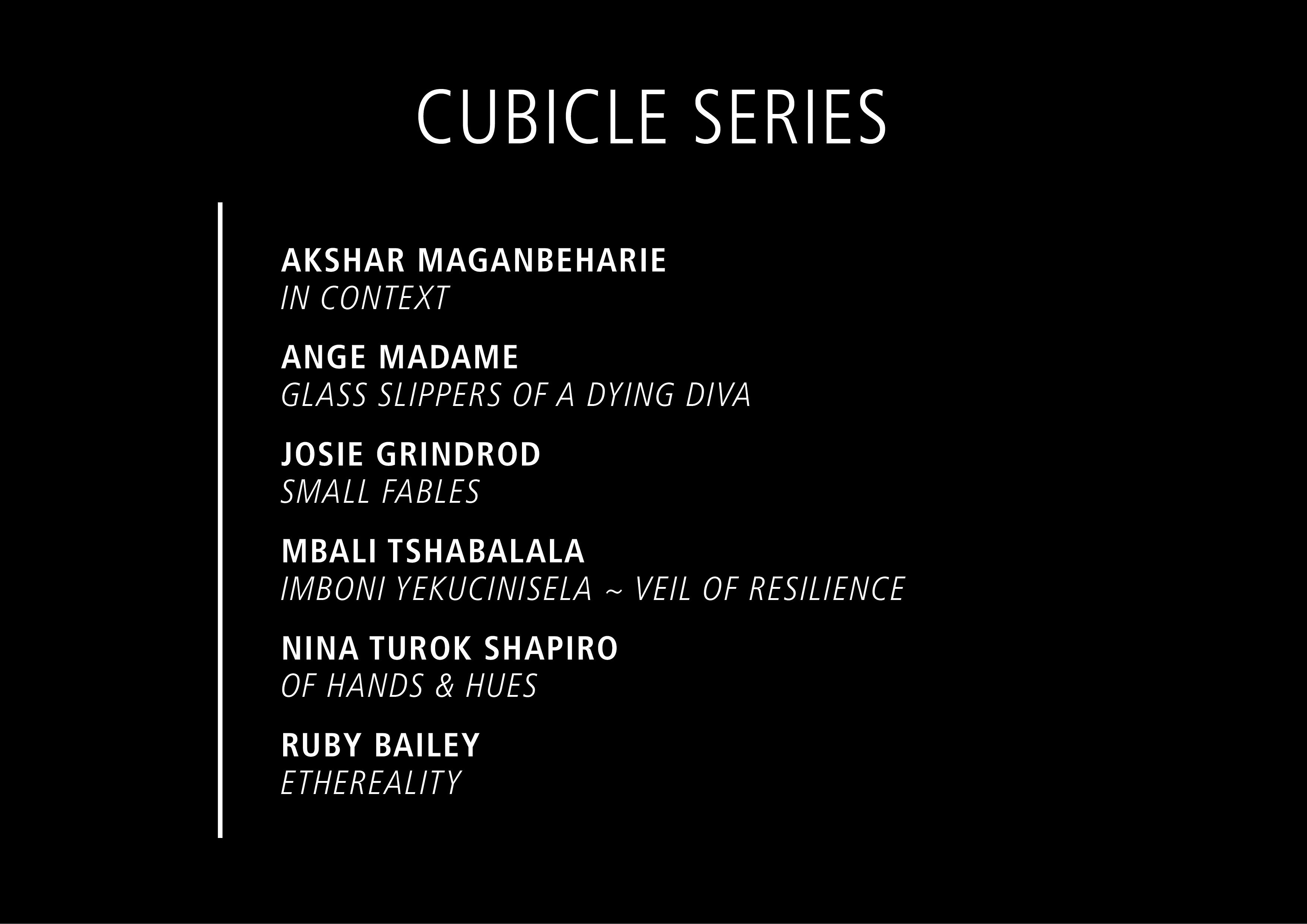PRESS RELEASE

CUBICLE Series January 2025
Jan 13 – Jan 25, 2025
Cubicle is an ongoing platform at CIRCA Cape Town, giving artists scope to exhibit smaller bodies of artworks and site-specific installations for a two week period.
WALKABOUT & DRINKS ON THE LAWN 10:30 SATURDAY 25th JANUARY
Featuring:
AKSHAR MAGANBEHARIE | IN CONTEXT
ANGE MADAME | GLASS SLIPPERS OF A DYING DIVA
JOSIE GRINDROD | SMALL FABLES
MBALI TSHABALALA | Imboni Yekucinisela ~ Veil of Resilience
NINA TUROK SHAPIRO | OF HANDS & HUES
RUBY BAILEY | ETHEREALITY
CLICK HERE TO REQUEST A PORTFOLIO
AKSHAR MAGANBEHARIE | IN CONTEXT
The title ‘In Context’ refers to things being taken out of context, processed, and represented. In this body of work, I have used colour, shape, and line to process and represent different pop culture references and personal observations. A pop culture reference inspires each abstraction or is an observational exploration in mark-making. I have recently been interested in the act of drawing and mark-making and the intersection of drawing and painting and how they work together in abstraction.
ANGE MADAME | GLASS SLIPPERS OF A DYING DIVA
As we all know, Cinderella left behind her glass slipper. Though many other people tried it on, it never fit them as it was made through enchantment by Cinderella’s fairy godmother. Similarly, this body of work shows how the singularity of “oneness” doesn’t always fit us – with the aim of both unifying and disrupting, all from the point of view of a non-conforming body doing everything at once with regards to identity, race, gender, sexuality. This questioning is a tool to change and challenge how reality is perceived through a shallow mind. We allude to ourselves and others as one person; we worship different singular deities; we celebrate only one birthday a year. Transness has been the forefront of conversation in global politics. It demonstrates a lack of “one”, a destruction of “one”, exploring the spectrum of a binary rather than a single point. Cinderella’s glass slipper reminds us we all have a journey to embark on. Would you claim the slipper and be dishonest? Or is it truly yours? What is that, one may ask. It is your truth.
JOSIE GRINDROD | SMALL FABLES
My work explores notions of enchantment. Revisiting the world of fable – a genre which seeks to combine moral instruction with the aesthetically pleasing – I’ve looked at medieval and Renaissance images, fairytale and children’s book illustrations, theatre props and scenic drawings, as well as at art history.
I’m interested in how images are carried forward in culture and in how they are mediated by technologies reproducing and transforming them. In considering this image transfer I’ve explored older methods of scaling up, stencil making and “pouncing”, as well as more contemporary approaches such as internet searches, photographic projection and the photocopy.
The relationship between humans and the natural world – celebrated as symbolic and sacred in the bestiary of medieval times – is the focus of my consideration. I hope to rekindle an animist sense of wonder at transmutation in which plants, animals and the very stones may be helpers – spirit guides for the Waste Land grail quest of end times.
MBALI TSHABALALA | IMBONI YEKUCINISELA ~ VEIL OF RESILIENCE
My work examines the systems that shape us – societal and governmental structures that claim to enforce, embody or distort order. Through my art, I explore how order can be interpreted, dismantled and reimagined, weaving both personal and universal reflections into this inquiry. As a woman, my experience within these systems is shaped by a constant tension between imposed structures and the resilience required to navigate them. Women, particularly in spaces like Johannesburg, are often tasked with holding together fragile frameworks while adapting to instability and chaos. This duality informs my perspective, where the act of creating becomes both a reclamation and a reimagining of order. Downtown Johannesburg, alive in its contradictions, reflects these dynamics. Fleeting moments of balance and structure emerge from the city’s relentless energy – a harmony found in chaos. This interplay mirrors the rhythms of nature, where fractals, cycles and symmetry reveal a hidden organization that holds chaos and balance in tension. These patterns also speak to a deeper, spiritual order – a profound alignment within the universe where resilience and transformation become acts of quiet power.
The title Imboni Yakucinisela, meaning “a vision of resilience” in Swati, encapsulates this exploration. Resilience doesn’t restore balance to its original state; it adapts, transforms and redefines it. This reflects not only the universal process of finding strength through disruption but also my own journey of seeking clarity and purpose within systems that resist stability. On a philosophical level, my work invites reflection: What is order? How do we construct it, and how does it shift under the weight of life’s uncertainties? Order often presents itself as solid and unchanging, yet it is fragile and transient, revealing itself only in fleeting moments before dissolving. Resilience, in turn, becomes the act of shaping chaos into something meaningful, even if only temporarily. Veil of Resilience (Imboni Yakucinisela) is about uncovering these moments of transformation, exploring how order, resilience, spirituality and my lived experience as a woman intersect. It is an invitation to engage with the fluidity of concepts that resist being pinned down, yet remain profoundly human.
NINA TUROK SHAPIRO | OF HANDS & HUES
‘Of Hands and Hues’ explores memory, nostalgia, and familial history through abstraction. Shapiro constructs a visual archive based on her own affiliative post-memory – that which is “remembered” by a postgeneration – exploring how history is both preserved and reimagined.
Shapiro uses her family’s photographic archives, distorting and cropping the original photographs to reflect the fluid nature of memory. By focusing on hands and points of contact between figures in the frame, Shapiro moves away from traditional portraiture, offering instead a more intimate, anti-portrait approach highlighting the traces left by her ancestors. Anti-portraiture conceals or masks the identity of the subject of an image, shifting focus towards contextual clues within the image. The work reflects the tension between the known and the unknowable in the ongoing process of remembering.
The silk-screen printing process lends itself to the repetition and abstraction of certain imagery. This echoes the repetitive nature of story-telling and narrative building, in which information is lost or morphed in each retelling. The boundaries between analogue and digital processes become blurred, resulting in a memory landscape wherein moments of combining different media become frames of parallel narratives.
Shapiro draws from Josef Albers’ discussion of the inherent relativity of colour in his book, ‘Interaction of Colour’ (1963). Each colour and its hue influences how the viewer’s eyes perceive the next. This reflects the spatial, cultural and generational relativity of an affiliative postmemory.
RUBY BAILEY | ETHEREALITY
‘Ethereality’ explores the intersections of technology, identity and speculative futures through sculpture, analogue interactive artworks, digital prints, video, and ‘encrypted’ works. The exhibition imagines a world where the boundaries between the physical and digital blur, presenting tools, environments and symbols that, together, build an internet-inspired, digital-pastoral ‘Ethereality ’. Resin casts of Acheulean-age hand axes, enlarged and embedded with fragments of metal and technology, are reimagined as artifacts from a speculative future species. The original hand axes, crafted over 30,000 years ago by a pre-Homo sapiens species, are transformed into futuristic tools made from a material Bailey calls "solid air." These works connect ancient craftsmanship with imagined materials, serving as interspecies collaborations linking past, present, and future.
Bailey’s "interactive paintings" combine laser-cut steel panels and movable vinyl magnets printed with digital collages of her screenshots and secrets. These analogue interfaces invite viewers to rearrange elements, creating dynamic and fluid compositions that mimic digital aesthetics while emphasising tactile interaction. Similarly, crudely ‘encrypted’ works transform Bailey’s nude selfie into ASCII text, presented as both a fine paper print and a laser-cut aluminium panel. These pieces abstract identity into symbolic language, exploring themes of visibility, privacy, and representation. Sculptural works, finished in reflective chrome, incorporate airplane parts, chains, and symbolic cutouts like grass, cursors and encrypted silhouettes. An acrylic piece features ID-photo-sized, wide-angle portraits from nights out, arranged to spell ‘r u a robot?’ in a coded font. Referencing CAPTCHA tests, this work questions boundaries between human and artificial identity.
The video work *Endlessity* layers AI imagery, personal footage, and digital landscapes to examine the interplay between presence and absence. These interconnected works reflect on how technology reshapes identity and the environments we inhabit, presenting a speculative vision of continuity, transformation, and blurred boundaries.



